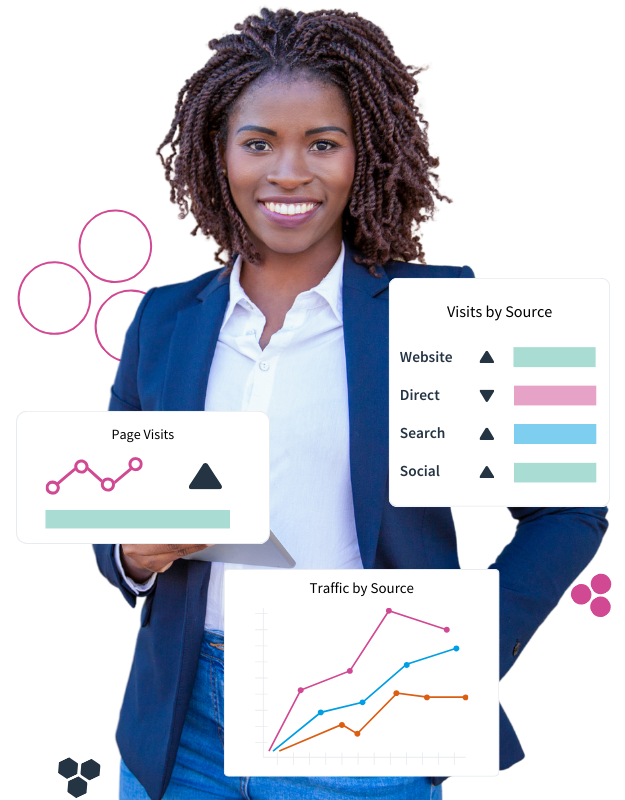Imagine a world where numbers and analytics line up across all company departments. The metrics are accurate, reports are plentiful, and consumer data is accessible and available to the right departments, teams, and employees. Sound too good to be true? It’s not.
How many times have you been in a meeting where cross-departmental data doesn’t add up? The marketing team reports “X” number of pageviews from last month, the data team announces “Y” number, and the sales team reveals “Z.” Office data wars are real. [Mic drop.]
That frustrating situation is extremely common, and it’s because of data silos. When teams rely on different reporting tools and systems, it’s impossible for analytics to align. And without accurate metrics and data, it’s hard for a company to maximize profits, perform efficiently, and make strategically sound decisions. Enter: data democratization.
What is data democratization?
The fancy definition: Data democratization is the process of enabling everyone in an organization (regardless of their technical proficiency) to have access to information in a digital format to use for informed decision-making purposes.
The simple definition: It’s getting the right data in the right hands. Data democratization breaks down barriers to empower employees to explore, analyze, and make decisions based on data, without driving your data scientists and analysts crazy.
The fun definition: It’s the archenemy of data silos.
Why is data democratization important?
When decisions are backed by real numbers and analytics, the results are monumental. According to a McKinsey report, organizations that embrace data-driven strategies are 23 times more likely to acquire customers, and 19 times more likely to be profitable than companies that don’t use data.
Data democratization encourages data transparency and fosters a culture of collaboration and innovation. It promotes self-service analytics so employees can leverage data themselves to make informed, empowered decisions without jeopardizing security or privacy protocols.
For example, say a marketing team is looking for insights and data to fuel its next campaign. With data democratization in place, team members already have access to the consumer data needed to discover trends, uncover customer preferences, and tailor their campaign strategies accordingly. They don’t have to contact the IT department for data permissions or bother data analysts for specific reports. Instead, the marketing team has all the data needed to streamline its process and make informed decisions.
Data democratization also enables a company to shift from “intuitive” decision-making to a data-backed strategy. When decisions are rooted in data-backed evidence, businesses can deliver better consumer experiences to enhance profitability.
How can a company democratize data to get it in the right hands?
To get the right data in the right hands you need to understand what data is needed and by whom, efficiently capture the data, and control access to the data. The first part is as simple as asking. The rest is where most organizations struggle.
The first step is making sure you’re capturing all the data. This demands an advanced data capture platform, which we’ll talk about shortly. Then it’s about accessing the data. Many analytics systems limit data sharing and don’t offer customizable accessibility options. A “one-size-fits-all” approach to data delivery results in one of two outcomes: a team gets too much of the wrong data, or a team gets too little of the right data. Neither option is beneficial to productivity or business development.
Providing data access to everyone in an organization sounds like a heavy lift, but with the right data capture and analytics solution, it’s simple. Here’s how to get the right data in the right hands.
Commit to a central source of truth
Data democratization starts with a single source of truth. Most companies use different data collection and reporting systems across departments. This leads to errors, inaccurate metrics, and data silos.
A silo is a collection of data that’s isolated from the rest of an organization. It’s typically controlled by a specific department, team, or individual, and it doesn’t play well with others. Data silos lead to fragmented information, duplicate and inconsistent data, resulting in skewed analytics and inaccurate reporting.
A centralized data system breaks down silos by serving as a single source of truth. When data is collected, stored, and shared within a central environment, it eliminates discrepancies, reduces errors, and eradicates accessibility barriers. This unified data system enables teams and departments to access and share data easily to streamline processes, improve efficiency, and increase accuracy. Everyone’s looking at the same data, which feeds the analytics, which feeds the strategy. No more office data wars!
Look for customizable permissions
Most data systems come with permission and accessibility limitations, but organizational access needs are rarely black and white. Employees shouldn’t be buried beneath data that doesn’t pertain to their role, and they can’t have access to data they shouldn’t be able to see. However, if you restrict access too much you kill data democratization. A “one-size-fits-all” approach to data accessibility isn’t beneficial for any organization.
The right data capture and analytics solution makes it easy to customize data access for employees and departments based on any parameters needed. Data can be “sliced and diced,” leveraged, and made instantly available to ensure the right employees have access to the data they need within the analytics platform when they need it — without jeopardizing security or privacy.
Embrace compliance
From browser restrictions to third-party cookie deprecation, privacy regulations are constantly evolving and posing data capture challenges for analytics solutions. Regulations like GDPR and CCPA mean a lot of valuable data isn’t being captured. And recently, healthcare marketers have been under fire by government entities for using analytics platforms that can’t keep up with HIPAA rules and regulations. While a centralized data system allows for more control and monitoring of data access (and reduces the risk of unauthorized access), a first-party data capture platform is key to full compliance.
A true first-party solution is installed within your organization’s controlled environment, so data is never sent to an external location like a third party. Keeping the data under one roof and within your organization’s four walls ensures consumer privacy regulations are met. Having more granular permissioning and access control, as mentioned earlier, also increases compliance.
Leverage an advanced data capture platform
Up-to-date consumer analytics fuel in-the-moment marketing decisions to deliver personalized experiences. But your analytics and reports are only as good as the data that’s collected. Most analytics platforms aren’t able to capture accurate data because of browser restrictions, data timeouts, and poor execution (i.e. flawed tagging). When visitor data gets expired, or cross-domain tracking isn’t possible, you end up with either missing or duplicate data. If your reporting shows three separate visitors when in fact it was the same individual, your analytics are skewed — and your decision making will be too. An advanced data capture platform uses a combination of tools and technologies to make sure nothing is missed — or double counted. Here’s what to look for:
- A tagging-free solution solves for inaccurate and missing data by automatically capturing consumer interactions without the need for extra data layers or tag management. Accurate and complete data equals trustworthy analytics.
- Live-time data capture instantly processes and delivers data for use in reporting to improve accuracy and usability. Make sure your solution delivers both live-time data capture and activation.
- Identity stitching captures and stitches data across domains, sessions, channels, and devices in live time to create a detailed picture — and complete understanding — of consumer behavior. When a single consumer’s actions are recognized and unified across all touchpoints, it improves the accuracy of your analytics.
- A single data model feeds mobile web, web, and mobile app data into the same instance to unify data and eliminate data silos.
All for one and one for all: democratized analytics
Data silos, conflicting systems, and sharing restrictions are hurting your organization’s decision-making efforts. Companies realize the importance of data, but they’re still leaving employees in the dark on metrics, analytics, and consumer insights.
The best approach to utilizing data effectively is to democratize it across the entire organization. With a fully customizable, compliant, single source of truth in place, getting the right data in the right hands is effortless.

Take Celebrus Digital Analytics for a test drive!
Book a personalized demo to experience the true meaning of democratized, compliant data and analytics.







